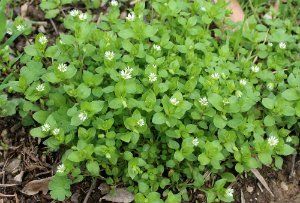Description: Chickweed, scientifically known as Stellaria media, is an annual or winter annual herbaceous plant belonging to the Caryophyllaceae family. It is characterized by its small, delicate leaves, paired opposite each other on the stem. The plant produces tiny, star-shaped white flowers with deeply notched petals. Chickweed is a versatile and adaptable weed, found in a variety of environments globally.
Habitat and Distribution: Chickweed thrives in moist, fertile soil and is commonly found in gardens, lawns, cultivated fields, and disturbed areas. It is native to Europe but has become widespread in North America and other regions, often considered an invasive weed due to its ability to colonize open spaces rapidly.
Physical Features: Leaves: The leaves are oval or elliptical, small, and opposite each other on the stem. They are usually hairless and have a succulent texture.
Flowers: The white flowers have five deeply lobed petals, giving them a star-like appearance. They bloom throughout the growing season.
Invasive Characteristics: Chickweed is known for its prolific seed production, quick germination, and ability to form dense mats, outcompeting other plants. Its adaptability to various soil types and climates contributes to its potential invasiveness.
Control Methods:
- Manual Removal: Hand pulling or using garden tools to uproot Chickweed is effective for small infestations. Removing the entire plant, including the root system, helps prevent regrowth.
- Mulching: Applying a layer of organic mulch around desirable plants can help suppress Chickweed growth by blocking sunlight and reducing soil temperature. Mulching also conserves moisture and improves soil health.
- Herbicides: Selective herbicides designed for broadleaf weed control can be used to target Chickweed. Carefully follow application instructions, especially in garden or lawn settings, to avoid harm to desirable plants.
- Cultural Practices: Practices such as proper lawn maintenance, regular mowing, and avoiding overwatering can create conditions less favorable for Chickweed growth. Promoting a healthy and dense turf or garden reduces opportunities for weed establishment.
Preventing Spread:
- Early Detection: Regularly inspecting gardens, lawns, and cultivated areas for signs of Chickweed is crucial for early detection. Prompt removal can prevent the spread of seeds.
- Improving Soil Health: Enhancing soil health through proper fertilization and pH management can discourage Chickweed growth and promote the success of desirable plants.
Competition with Other Plants:
Planting competitive ground covers or companion plants can help limit Chickweed spread. Examples include:
- Creeping Thyme (Thymus serpyllum): Forms a dense mat, suppressing weed growth.
- Clover (Trifolium spp.): Acts as a ground cover, competing with Chickweed for resources.
In conclusion, controlling Chickweed requires a combination of manual, cultural, and, in some cases, chemical control methods. By understanding its invasive characteristics and implementing effective strategies, it is possible to manage and mitigate the impact of Chickweed in various settings.



